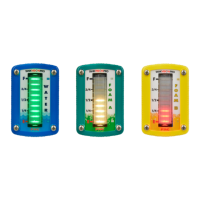WLA300 Rev170606
22
CALIBRATION
The TankVisionPro has unique calibration programs that enable it to be used on
tanks of all shapes and sizes.
Note: The standard pressure sensor is limited to a maximum tank height of
ten feet.
Overview
Magnet Sensor
The calibration programs are accessed by activating the C 1 and C 2 magnet
sensors that are located on the front of the display module. The sensor is activated by
placing the north or south pole of a small magnet in close proximity of the sensor. The
magnet is then moved about 1-inch away, this will produce an electronic signal that is
similar to a button being released. If the LEDs in the display do not change try moving
the magnet further away from the sensor.
In these procedures the term ‘swipe’ will mean to move the magnet up to and then
away from the magnetic sensor.
Non-Linear Calibration
The rst program is a non-linear calibration procedure that can be used for any shape
or size tank. This procedure must to be used for irregular shape tanks (e.g.: T-shape,
oval, elliptical, tank with through hole, etc.). The program compares the pressure in the
tank, as the tank lls at a steady rate, to time. This provides for very accurate displays.
Linear Calibration
The second program is a linear calibration procedure that can only be used when
the tank volume is proportional to the height. This would include square or rectangular
shape tanks with no irregularities. It is quick way of calibrating a tank but not as accurate
as the non-linear procedure. The program compares a full tank to an empty tank, takes
the difference and divides it into eight equal volume displays.
Full Tank Correction
This program is for use to ne tune the tank display after a non-linear or linear
calibration procedure has been completed. It would only be needed in cases where
one type of liquid is used for calibration when a different liquid would normally be in
the tank. For example this would allow the basic calibration of a foam tank to be done
using water and then the calibration would be ne tuned when the tank is lled with
foam concentrate.

